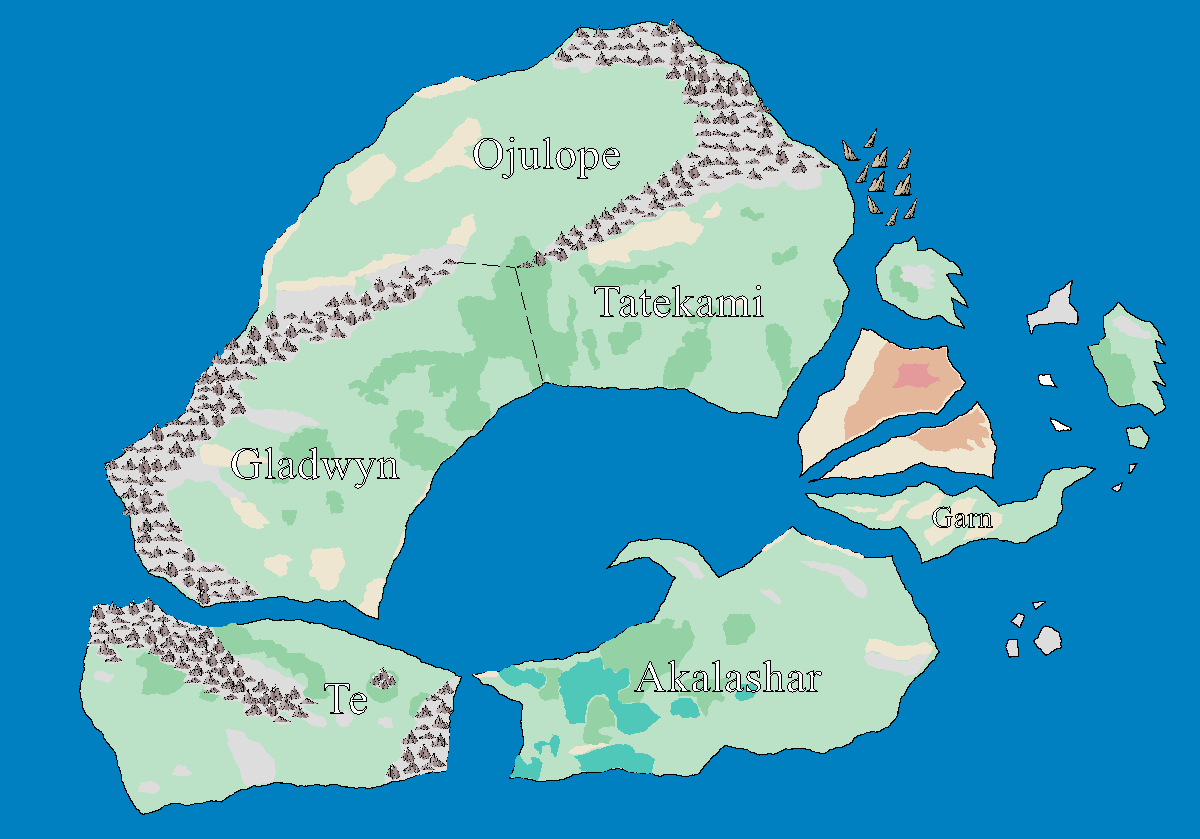The world of Nimbus has six continents, each with its own cultures, although the culture of the Empire of Light pervades the entire world.
Tatekami
The continent of Tatekami is the center of the empire and the only place where the emperor has real power. The Imperialists who live here carefully follow the philosophy of Light. The culture is defined by strict social hierarchies, respect for elders and those with higher social standing, loyalty to one’s family, and defined roles within the family, placing the father at the center. A small subculture in the cold, mountainous region in the northeast with a large dwarven population holds trained skill and craftsmanship in high regard, with craftsmen commanding a greater social standing than elders or high ranked officials. The countryside is fairly developed by the empire, with roads, aqueducts, and well-kept imperial churches and granaries across the continent. Imperial names for places and people sound similar to Latin and East Asian names on Earth.
Gladwyn
The continent of Gladwyn looks like an idyllic countryside, with forests and dales, moors and mountains. It is divvied up among warring kingdoms, each looking out for itself, part of the empire in name only. Among these kingdoms, Westvale is the largest and most powerful, and its king, Cedric, seeks to conquer the others on the continent and form a sovereign state to rival the empire. The Gladwynni people, however, value, above all else, peace and the pleasures that come with it. Among the pantheon of Light, they particularly revere Gladwyn and love to hold harvest festivals in his honor. Many also choose to worship Fey from the Fold on the eastern edge of the continent instead of the gods, following the philosophy of Earth, which also promotes peace. Gladwynni names for people and places sound similar to Celtic names on Earth.
Ojulope
The continent of Ojulope is divided into rough rocky and sandy terrain and large flat plains good for growing wheat and millet. Its large central kingdom has imperial culture and is the breadbasket of the empire. In this kingdom, people seek the wisdom of the gods when faced with challenges. In surrounding territories, however, a more nomadic culture holds sway that values common sense wisdom and freedom. In the northeast of the continent there is also a small fanatical theocracy centered around a prophet named Tiresias who can purportedly see the future without the aid of the gods. Imperial Ojulopans use names that sound like latin and asian names like the rest of the empire and nomadic Ojulopans use names that sound like they are from Earth’s nomadic peoples, such as the native peoples of America, Mongolia, and Sub-Saharan Africa.
Te
The continent of Te is particularly mountainous for its size, with the areas around the mountains full of rocky hills and evergreen forests. Inside one of the largest mountains in the middle of the continent is the dwarven city of Taghlakuhm, widely regarded as the birthplace of dwarves, where the greatest craftsmen in the world may be found. In Taghlakuhm, and in Te at large, personal skill is prized above all else, whether it be skill at arms, crafting, or mining. Most prefer to hone their chosen skill over pursuing power or honor. The ideal of an ascetic master of an art is widespread as an end goal. The Teg people use names similar to Tolkien’s dwarves and elves and occasionally names that sound like Germanic names on Earth.
Akalashar
The continent of Akalashar rises from low lying swamps and marshes in the west to slightly elevated chalky hills in the east. Only in the middle is the land particularly good for farming, with the strongest kingdoms built around regularly flooding rivers. The city states of the Crescent Alliance, who are in open rebellion of the empire, command the most power on the continent, with fleets of merchant ships bringing in vast quantities of silver and all manner of foriegn goods. This mercantilism has spread to the rest of the continent and the dominant culture among the Akalashari people is one of cutthroat profiteering. Persecution of the Akalashari by Imperialists because of the sins of the god their continent is named after has left most Akalashari distrusting of the empire and the Pantheon of Light. In fact, Akalashar has the most followers of Shadow of all the continents. Although all continents have some areas where the Shadow is in force and the dead will rise, Akalashar has the most, with large swaths of the western and eastern sides of the continent populated entirely by undead. Akalashari names for people and places primarily resemble Persian names on Earth, but can also sound similar to names from nearby geographical areas on Earth as far west as Egypt or as far north as Russia.
Garn
The continent-sized area labeled as Garn on most maps is an archipelago of largely independent islands, usually not capable of supporting more than one city. The most famous city among these is Garn, hence the name of the region at large. The city of Garn is a well developed metropolis whose people value knowledge and freedom. It has an unusually high number of gifted arcanists, which has accelerated its development and prompted people from around the world to come there to study the arcane arts. Surrounding islands have a variety of cultures, but all value freedom and respect the sea. On the island of Kelepenui is an ever-burning crater that Flamekin emerged from at the dawn of time. Between their proximity to the crater and the value they place on freedom, the people of Garn and the surrounding islands have the most followers of Fire of all the continents. In Garn and the surrounding islands, names used resemble those used by island cultures on Earth, such as Anglo-Saxon names, names from the Pacific Islands and Iceland, plus pirate names.
